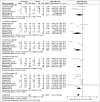The use of lidocaine infusion in laparoscopic cholecystectomy: An updated systematic review and meta-analysis
- PMID: 38240330
- PMCID: PMC11354941
- DOI: 10.4103/jmas.jmas_265_23
The use of lidocaine infusion in laparoscopic cholecystectomy: An updated systematic review and meta-analysis
Abstract
Being one of the most common abdominal surgical procedures, numerous techniques have been adapted to decrease post-operative pain post cholecystectomy. However, the efficacy of intravenous (IV) lidocaine in managing post operative pain after LC is still controversial, according to many recent studies. This study aims to detect the effectiveness of IV lidocaine compared to other medications in managing post-operative pain. PubMed, Scopes, Web of Science and Cochrane Library were searched for eligible studies from inception to June 2023, and a systematic review and meta-analysis was done. According to eligibility criteria, 14 studies (898 patients) were included in our study. The pooled results of the included studies showed that the pain score after 6, 12 and 24 h after the surgery was significantly lower in those who received IV lidocaine as a painkiller (Visual Analogue Scale [VAS] 6H, mean difference [MD] = -1.20, 95% confidence interval [CI] = -2.20, -0.20, P = 0.02; I2 = 98%, VAS 12H, MD = -0.90, 95% CI = -1.52, -0.29, P = 0.004; I2 = 96% and VAS 24H, MD = -0.86, 95% CI = -1.48, -0.24, P = 0.007; I2 = 92%). In addition, IV lidocaine is associated with a significant decrease in the opioid requirement after the surgery (opioid requirements, MD = -29.53, 95% CI = -55.41, -3.66, P = 0.03; I2 = 98%). However, there was no statistically significant difference in the incidence of nausea and vomiting after the surgery between the two groups (nausea and vomiting, relative risk = 0.91, 95% CI = 0.57, 1.45, P = 0.69; I2 = 50%). Lidocaine infusion in LC is associated with a significant decrease in post operative pain and in opioid requirements after the surgery.
Copyright © 2024 Copyright: © 2024 Journal of Minimal Access Surgery.
Conflict of interest statement
There are no conflicts of interest.
Figures




References
-
- Wittenburg H. Hereditary liver disease: Gallstones. Best Pract Res Clin Gastroenterol. 2010;24:747–56. - PubMed
-
- Joshi GP, Schug SA, Kehlet H. Procedure-specific pain management and outcome strategies. Best Pract Res Clin Anaesthesiol. 2014;28:191–201. - PubMed
-
- Chou R, Gordon DB, de Leon-Casasola OA, Rosenberg JM, Bickler S, Brennan T, et al. Management of postoperative pain: A clinical practice guideline from the American Pain Society, the American Society of Regional Anesthesia and Pain Medicine, and the American Society of Anesthesiologists'committee on regional anesthesia, executive committee, and administrative council. J Pain. 2016;17:131–57. - PubMed
-
- Rosero EB, Joshi GP. Hospital readmission after ambulatory laparoscopic cholecystectomy: Incidence and predictors. J Surg Res. 2017;219:108–15. - PubMed
LinkOut - more resources
Full Text Sources

